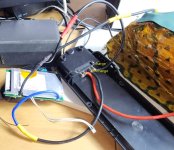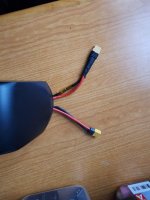WIthout knowing the complete details of the system, I can't give an accurate simple answer, (and my math isn't perfect even if I did have all the details) but here are some thoughts on how it would work that should let you answer it:
If it is not a common port BMS on the pack, you will be charging thru an unprotected port, so the BMS cannot stop a charge process regardless of pack condition or faults.
If it is a common port BMS then it can protect against charging or discharging during faults and pack conditions outside of limits, etc.
If the current from the panels is not greater than the current pulled from the battery, it won't go down the common length anyway, and will instead pass directly to the discharge arm of the Y splitter from the connector joining it. The common length would then carry less current, or none if the panels are supplying enough for the system to run from, up to the point where the panels can supply more current than the system needs to run *and* the cells are at a lower voltage than the panel voltage.
This connector then becomes the limiting factor, along with the two arms of the Y splitter involved. As long as those two sets of conductors are of sufficient cross section for the current required, and the connector is, then there shouldn't be a problem.
If current does have to flow to the battery via the new common length of wiring (the part between the cells and the splitter):
If the total conductor cross section of the new common length of wiring is the same as the original paired wires total, then they can carry the same current, assuming that the connector contacts are capable of doing so.
If the new common length of wiring has a crossection smaller than the total of the original paired wires, then it's carrying capacity is proportinally less.
If the smaller crosssection is still larger than is required for the current being used, it would still be able to do the job.



